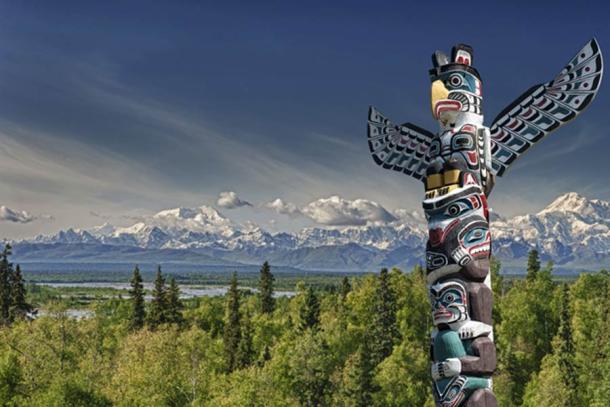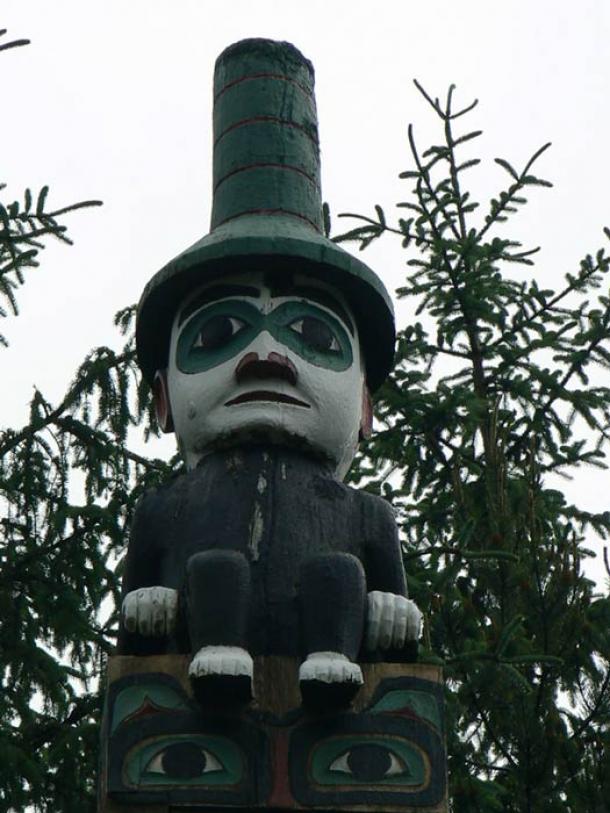
Every Totem Pole Tells a Story
Totem poles are a type of monumental structure carved from the trunks of huge trees, especially the Western Red Cedar. These monuments are found in North America, specifically along its north-western coast, and are traditionally created by a number of Native American groups. While the oldest totem poles that we know are from the 19th century, it has been suggested that this tradition has existed since long before then. Totem poles are rich in symbolism, and were used for a variety of purposes.
The Growth of the Poles
The carving of totem poles is a practice among certain Native American groups, including the Haida, the Chinook, and the Tlingit tribes. One theory that has been proposed is that this type of monument developed from the elaborate carvings of interior door posts, funerary containers, and memorial markers.
During the 18th century, European travelers along the north-western coast of North America recorded seeing totem poles during their travels, though these were small and few in number. Today, however, no known totem pole dates to before the 1800s. The explanation for this is that the region’s climate is not conducive to the preservation of wooden artifacts, and serves to exacerbate the decay of these monuments.

Tlingit totem pole in Ketchikan, Alaska, circa 1901. (Public Domain)
One of the important developments in the history of totem pole production was the introduction of metal tools. Prior to this, totem poles were much smaller in size, roughly equivalent to the height of a walking stick. This shorter size makes sense when one considers that early totem pole artists crafted the poles by hand using sharpened stones, sea shells, bones or beaver teeth.
The use of metal tools, however, allowed the totem pole makers to create much larger monuments far more easily. It is unclear if these Native American groups first acquired metal tools from European settlers, or if they had recovered such tools previously from European shipwrecks. In any case, contact with Europeans enabled the Native Americans to obtain metal tools more easily.
- Why Isn’t This Map in the History Books?
- Birds, Stones, and Jaguars: Piecing Together the Multifaceted Ancient Olmec Religion
- 6,000-year-old carved phallus artefacts found in Papua New Guinea

A magnificent totem pole. (Andrea Izzotti /Adobe Stock)
In addition, the fur trade brought great wealth to the Native American tribes of the area. One of the ways in which this wealth was spent and distributed was through gift-giving feasts known as potlatches. These celebrations are often associated with the construction of totem poles.
Such poles were erected to symbolize the wealth and social status of a leader, as well as the importance of his family and clan. Therefore, the use of metal tools and the increase of wealth among the Native American tribes of the coast resulted in the production of more totem poles, which were also larger in size, quite different from what was observed by European travelers during the 1700s.

Totem poles in Stanley Park. Vancouver, British Columbia, Canada. (Ferenc /Adobe Stock)
Totem Poles: Crafted with a Purpose
Whilst potlatches are said to be the original reason for totem poles to be erected, these monuments were also carved for a variety of other purposes later on. For instance, some totem poles were produced for the purpose of commemorating the life of an important person, whilst others functioned as grave markers. Totem poles can also tell the real or mythical stories of the families and clans they represent.
Totem poles were sometimes created to welcome or scare away strangers. Another interesting type of totem pole is the ‘shame pole’. These were erected to publicly shame individuals / groups for unpaid debts, quarrels, as well as other unpleasant actions. On the other hand, totem poles were also created to celebrate happier events such as weddings.

The Seward Pole, located in Saxman Totem Park in Alaska, was made to shame someone. (Charley_K/CC BY NC-SA 2.0)
Incidentally, totem poles were once assumed, by early Christian missionaries in the area, to have been objects of worship. This, however, is incorrect, as the totem poles were never worshipped by the peoples who made them.
- Did a Native American travel with the Vikings and arrive in Iceland centuries before Columbus set sail?
- A Glimpse into the Intuitive Medicine of the Native American Tradition
- Evolution of a Native American Society: A Journey Through Ancient History
Totem Pole Design Features
In general, traditional totem poles utilize a common design motif with symbolic animals and spirits. Some of the animals commonly seen on totem poles include the raven, the wolf, the frog, the eagle, and the killer whale. These animals are representative of certain traits, for example:
- The Raven – creation, transformation, knowledge, and the subtlety of truth
- The Wolf - supernatural powers and hunting abilities, loyalty, family ties, communication, education, and intelligence
- The Frog - wealth, abundance, ancient wisdom, rebirth, good luck, healing, the bridge between the human and spirit worlds
- The Eagle - focus, strength, peace, leadership, friendship, and ultimate prestige
- The Killer Whale - family, romance, longevity, harmony, travel, community, and protection
In terms of color, natural pigments were used. The artist traditionally had a limited choice of colors, which included black, red, white, and green.
- Black – power
- Red – blood, war, valor
- White – purity, peace, death
- Green – the earth, hills, trees
Nevertheless, the choice of colors used to decorate the totem pole depends on the individual tribes; and so the colors, like the animals on the poles, may also have different, more personal meanings.

A beautiful old totem pole. (Martina /Adobe Stock)
Top Image: A totem pole. Source: rabbit75_fot /Adobe Stock
By Wu Mingren
Updated on October 22, 2021.
References
Alchin, L., 2017. Totem Poles. [Online]
Available at: https://www.warpaths2peacepipes.com/native-american-culture/totem-poles.htm
Crystalinks, 2017. Totem Poles. [Online]
Available at: http://www.crystalinks.com/totempoles.html
DIFFERENTmedia, 2017. Totem pole Basics. [Online]
Available at: http://users.imag.net/~sry.jkramer/nativetotems/basics.htm
National Center for Families Learning, 2017. What Is a Totem Pole?. [Online]
Available at: http://wonderopolis.org/wonder/what-is-a-totem-pole
New World Encyclopedia, 2015. Totem pole. [Online]
Available at: http://www.newworldencyclopedia.org/entry/Totem_pole
















Comments
Just found this site. Interesting topics and lengthier coverage than many other sites. I am slightly curious though as to the usage of the word "whilst" in so many places. I only read a few articles, and saw the word probably seven times, four times in one article alone. (The totem pole article.) While whilst is a perfectly good word, it is a little antiquated, and tends to catch one's attention. (The last time I made this sort of comment, I got myself banned from a site, and I don't even remember what I said.) Anyway, like I said, just curious.
" It is unclear if these Native American groups first acquired metal tools from European settlers, or if they had recovered such tools previously from European shipwrecks. "
It's not unclear at all, and it was ships of the fur trade who carried metal tools for trade. There were no "settlers" at the time, just as "travellers in the 1700s" were known explorers and ships engaged in the fur trade.
BTW the term "Native American" only applies for tribes in the United States and is inappropriate for Canadian indigenous groups who are called "First Nations"; the safer term is "indigenous"
you didn't explain the eagle, killer whale, raven, frog, bear etc as clan symbols and inheritances; you had to inherit the right to use certain animals and symbols; totem poles are also believed to be the native response to the escutcheons on Spanish, Russian and British ships which were explained to them as heraldic devices - "hey we've got those too" - and the evolution of poles vs house posts and housefronts is known to derive from emulating ships' masts.
DHWTY,
Another great article. It seems you concentrate on north western tribes. Would like to hear about the rest of N. Americas totems. In northern Cali there are stories of bear totems. Some stories talk of bears actually coming down from the mountains and getting up on there hind legs to dance around there totems during or after ceremonies honoring them.
DHWTY,
Another great article. It seems you concentrate on north western tribes. Would like to hear about the rest of N. Americas totems. In northern Cali there are stories of bear totems. Some stories talk of bears actually coming down from the mountains and getting up on there hind legs to dance around there totems during or after ceremonies honoring them.